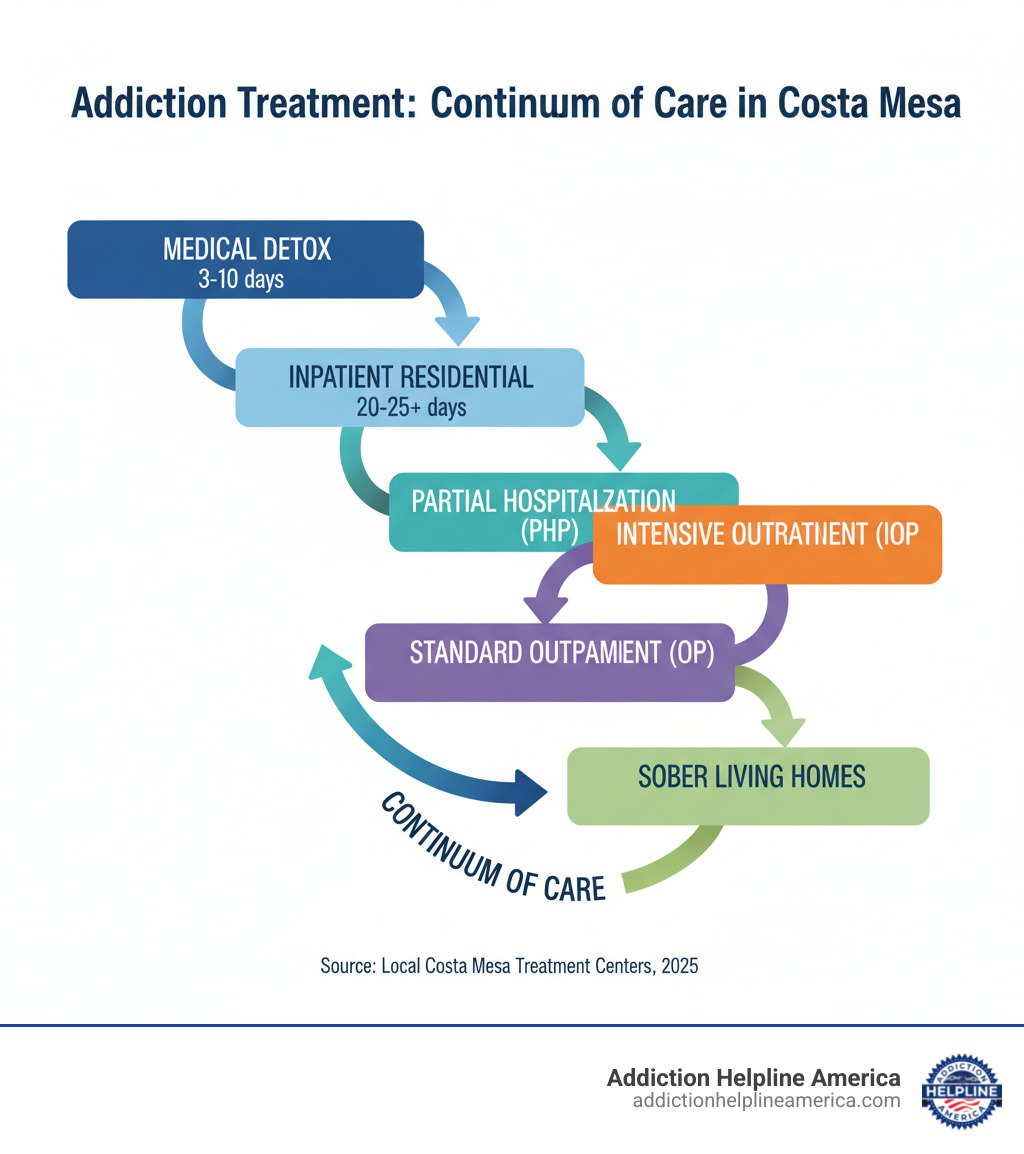
Why Finding the Right Costa Mesa Rehab Center Is Critical for Recovery
Drug rehab facilities in Costa Mesa offer hope and healing for individuals and families affected by addiction. If you’re searching right now, here’s what you need to know:
Quick Answer: Top Ways to Find Costa Mesa Rehab Centers
- Use online directories – Filter by insurance, treatment type, and specializations
- Contact your insurance provider – Verify coverage and find in-network facilities
- Explore local resources – Access community programs and state-funded options
- Get medical referrals – Ask your doctor or therapist for trusted recommendations
- Connect with support groups – Find peer recommendations through AA/NA meetings
The situation in Orange County is serious. In 2020 alone, there were nearly 1,200 opioid-related emergency visits and just over 500 overdose deaths. More than 1 million opioid prescriptions were written that same year. These numbers paint a stark picture of the addiction crisis affecting our community.
These aren’t just statistics; they represent friends, family members, and neighbors whose lives have been turned upside down. The ripple effects of substance abuse extend deep into the fabric of Southern California, straining healthcare resources, impacting families financially and emotionally, and creating cycles of trauma that can be difficult to break.
But here’s the important part: recovery is possible.
Costa Mesa sits in the heart of Orange County’s recovery community, serving as a guide of hope. The city is home to a dense network of high-quality treatment providers, creating a robust recovery ecosystem. This environment fosters a sense of community and shared purpose among those seeking sobriety. From serene coastal settings that promote healing to a wide array of specialized programs, Costa Mesa provides the resources and the atmosphere conducive to profound, lasting change.
The challenge isn’t finding a rehab center—it’s finding the right one for your specific situation. The sheer number of options can feel overwhelming. The ‘right’ center for one person may not be the best fit for another. A successful recovery journey depends on a treatment plan that is custom to your unique history with substance use, any co-occurring mental health conditions, your lifestyle, and your personal goals. This is why understanding the different types of care and how to vet them is so crucial.
At Addiction Helpline America, we’ve guided thousands of individuals and families through the process of finding and accessing drug rehab facilities in Costa Mesa and throughout Southern California. Our mission is to cut through the confusion and connect you directly with a program that aligns with your needs. Our 24/7 helpline is free, completely confidential, and staffed by compassionate specialists who understand what you’re going through and are ready to help.
This guide will walk you through five proven methods for finding quality addiction treatment in Costa Mesa, what to look for when choosing a facility, and what to expect from the admissions process through aftercare.

Simple guide to drug rehab facilities in Costa Mesa terms:
Understanding Addiction Treatment Levels in Costa Mesa
When you’re starting the journey to recovery, one of the first things you’ll encounter is the phrase “continuum of care.” It sounds clinical, but it simply means that addiction treatment comes in different levels—each designed to meet you exactly where you are in your recovery journey. This model is a core principle of effective addiction treatment. According to the National Institute on Drug Abuse (NIDA), no single treatment is right for everyone, and treatment needs to be readily available. The continuum of care ensures that as your needs change, your level of support can change with you, providing a seamless transition from intensive care to greater independence.
Think of it like climbing a mountain. You wouldn’t start at the summit. You begin at base camp, and as you build strength and skills, you move to higher elevations. Drug rehab facilities in Costa Mesa work the same way, offering different levels of support based on your needs, the severity of your addiction, and how far along you are in recovery.
The first step in recovery often begins with medical detox, followed by residential treatment, then outpatient programs, and finally sober living environments. Each level plays a vital role in building a foundation for lasting sobriety.

The Critical Role of Medical Detox
For many people struggling with alcohol or drug dependence, the body has become physically dependent on the substance. When you stop using, withdrawal symptoms kick in—and depending on what you’ve been using, those symptoms can range from uncomfortable to life-threatening.
That’s where medical detox comes in. This isn’t about willpower or toughing it out. It’s about safety and comfort during one of the most vulnerable phases of recovery. For example, withdrawal from alcohol or benzodiazepines can lead to dangerous seizures, hallucinations, and a condition known as delirium tremens (DTs), which can be fatal. Opioid withdrawal, while typically not life-threatening, causes excruciating flu-like symptoms, intense cravings, and severe emotional distress that make it nearly impossible to quit without medical support.
At a Costa Mesa Detox center, medical professionals monitor you around the clock. They track your vital signs, manage withdrawal symptoms with appropriate medications, and make sure you’re as comfortable as possible. In a medical detox setting, professionals can administer medications like buprenorphine to ease opioid withdrawal or use a tapering protocol for benzodiazepines to ensure your safety. Beyond physical stabilization, detox provides crucial psychological support to manage the anxiety, depression, and fear that often accompany early sobriety.
Most people complete detox in 3 to 10 days, though the timeline varies based on the substance and how long you’ve been using. The goal isn’t just to get through withdrawal—it’s to prepare your mind and body for the real work of recovery that comes next. Medical detox is truly the first step to sobriety, clearing the fog so you can focus on healing.
Inpatient vs. Outpatient: What’s the Difference?
Once detox is complete, you’ll move into a rehabilitation program. This is where you learn the skills, coping strategies, and insights needed to maintain sobriety long-term. But here’s where the path splits: inpatient residential treatment or outpatient programs.
Both are effective. Both save lives. The right choice depends on your situation, the severity of your addiction, your home environment, and your daily responsibilities.
Inpatient residential treatment means living at the facility for the duration of your program—typically 30, 60, or 90 days. You’re immersed in recovery 24/7, removed from triggers and old patterns. A typical day is highly structured to build new, healthy routines. You might start with morning meditation, followed by breakfast and group therapy. Afternoons often include individual counseling, educational workshops on relapse prevention, and holistic activities like art therapy or fitness. Evenings may involve 12-step meetings or peer support groups. This immersive structure removes the distractions of daily life, allowing you to focus entirely on healing.
Outpatient programs allow you to live at home while attending treatment sessions during the day or evening. These programs come in different intensities. A Partial Hospitalization Program (PHP) might have you in treatment for six hours a day, five days a week. An Intensive Outpatient Program (IOP) typically involves three hours a day, three to five days a week. Standard outpatient care is even less intensive—usually one to two sessions per week. Outpatient treatment is ideal for practicing new coping skills in real-time while still having the safety net of professional support. It requires a high degree of personal motivation and a stable, supportive home environment.
Many drug rehab facilities in Costa Mesa also offer sober living homes—structured, substance-free housing where you live with others in recovery. These homes bridge the gap between intensive treatment and independent living. Residents are typically required to follow house rules, such as curfews, attending 12-step meetings, submitting to regular drug tests, and contributing to household chores. This environment fosters peer accountability and helps individuals practice the skills learned in treatment before returning to fully independent living.
| Feature | Inpatient (Residential) Treatment | Outpatient Treatment |
|---|---|---|
| Living Situation | Live at the facility 24/7 | Live at home, attend scheduled sessions |
| Level of Structure | Highly structured, supervised environment | Flexible schedule, more independence |
| Intensity of Care | Immersive, around-the-clock support | Several hours per week (varies by program) |
| Ideal Candidate | Severe addiction, unstable home environment, co-occurring disorders | Stable housing, strong support system, mild to moderate addiction |
| Benefits | Removes you from triggers, provides constant support, intensive therapy | Maintain work/school, stay connected to family, lower cost |
The beauty of the continuum of care is that you don’t have to choose just one. Many people start with detox, move to residential treatment, step down to outpatient care, and live in a sober home during the transition. Your treatment team will help you determine the right path based on your progress, needs, and goals.
Our helpline is 100%
free & confidential
If you or someone you care about is struggling with drug or alcohol addiction, we can help you explore your recovery options. Don’t face this challenge alone—seek support from us.
Programs
Resources
Will my insurance
cover addiction
treatment?
We're ready to help
Find the best
drug or alcohol treatment
center
Are you or a loved one struggling with addiction? Call today to speak to a treatment expert.












